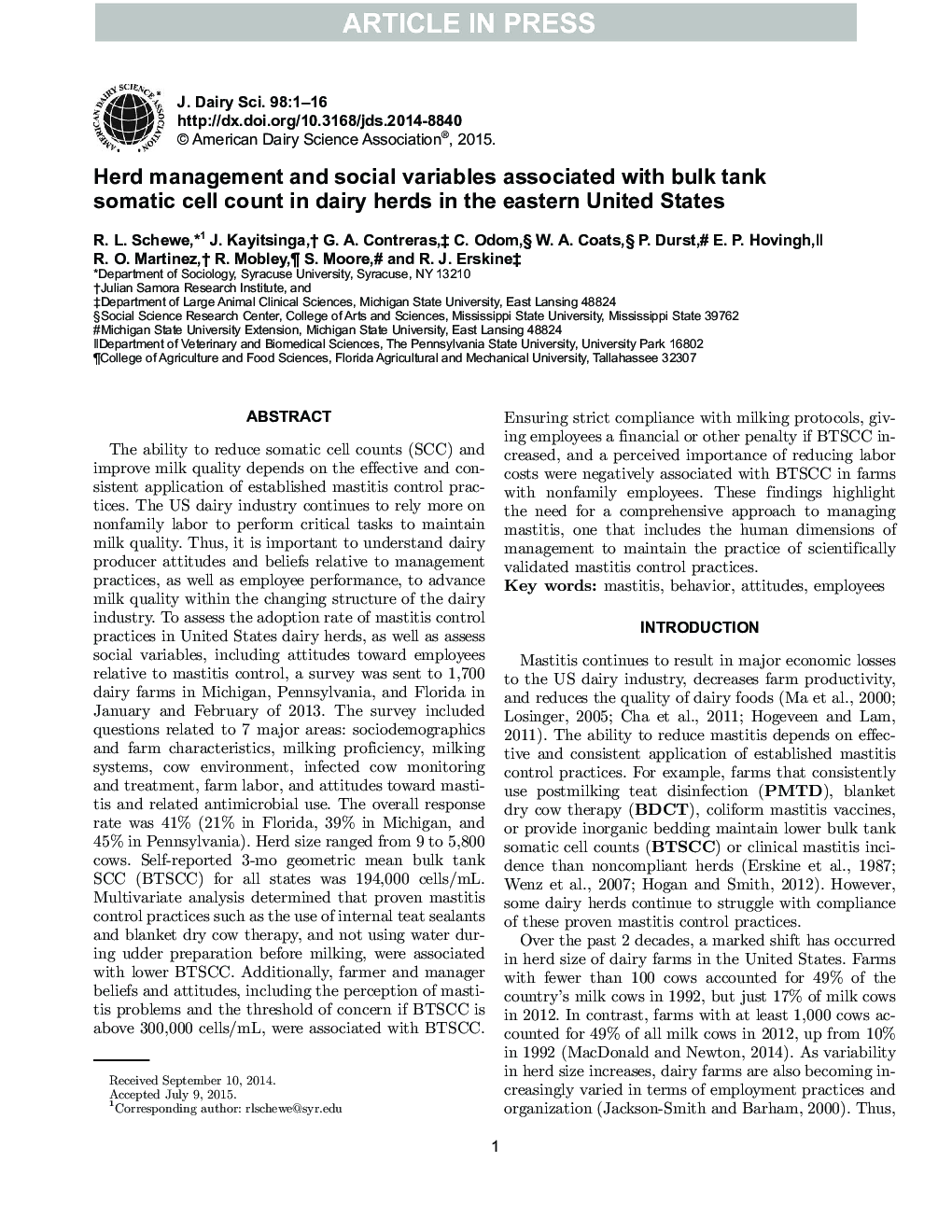| کد مقاله | کد نشریه | سال انتشار | مقاله انگلیسی | نسخه تمام متن |
|---|---|---|---|---|
| 10974523 | 1108026 | 2015 | 16 صفحه PDF | دانلود رایگان |
عنوان انگلیسی مقاله ISI
Herd management and social variables associated with bulk tank somatic cell count in dairy herds in the eastern United States
ترجمه فارسی عنوان
مدیریت گله و متغیرهای اجتماعی مرتبط با تعداد سلول های سمی مخزن فله در گاوهای شیری در شرق ایالات متحده
دانلود مقاله + سفارش ترجمه
دانلود مقاله ISI انگلیسی
رایگان برای ایرانیان
کلمات کلیدی
ماستیت، رفتار - اخلاق، نگرش های، کارکنان،
موضوعات مرتبط
علوم زیستی و بیوفناوری
علوم کشاورزی و بیولوژیک
علوم دامی و جانورشناسی
چکیده انگلیسی
The ability to reduce somatic cell counts (SCC) and improve milk quality depends on the effective and consistent application of established mastitis control practices. The US dairy industry continues to rely more on nonfamily labor to perform critical tasks to maintain milk quality. Thus, it is important to understand dairy producer attitudes and beliefs relative to management practices, as well as employee performance, to advance milk quality within the changing structure of the dairy industry. To assess the adoption rate of mastitis control practices in United States dairy herds, as well as assess social variables, including attitudes toward employees relative to mastitis control, a survey was sent to 1,700 dairy farms in Michigan, Pennsylvania, and Florida in January and February of 2013. The survey included questions related to 7 major areas: sociodemographics and farm characteristics, milking proficiency, milking systems, cow environment, infected cow monitoring and treatment, farm labor, and attitudes toward mastitis and related antimicrobial use. The overall response rate was 41% (21% in Florida, 39% in Michigan, and 45% in Pennsylvania). Herd size ranged from 9 to 5,800 cows. Self-reported 3-mo geometric mean bulk tank SCC (BTSCC) for all states was 194,000Â cells/mL. Multivariate analysis determined that proven mastitis control practices such as the use of internal teat sealants and blanket dry cow therapy, and not using water during udder preparation before milking, were associated with lower BTSCC. Additionally, farmer and manager beliefs and attitudes, including the perception of mastitis problems and the threshold of concern if BTSCC is above 300,000Â cells/mL, were associated with BTSCC. Ensuring strict compliance with milking protocols, giving employees a financial or other penalty if BTSCC increased, and a perceived importance of reducing labor costs were negatively associated with BTSCC in farms with nonfamily employees. These findings highlight the need for a comprehensive approach to managing mastitis, one that includes the human dimensions of management to maintain the practice of scientifically validated mastitis control practices.
ناشر
Database: Elsevier - ScienceDirect (ساینس دایرکت)
Journal: Journal of Dairy Science - Volume 98, Issue 11, November 2015, Pages 7650-7665
Journal: Journal of Dairy Science - Volume 98, Issue 11, November 2015, Pages 7650-7665
نویسندگان
R.L. Schewe, J. Kayitsinga, G.A. Contreras, C. Odom, W.A. Coats, P. Durst, E.P. Hovingh, R.O. Martinez, R. Mobley, S. Moore, R.J. Erskine,
